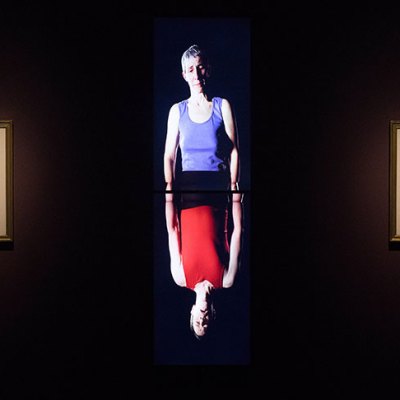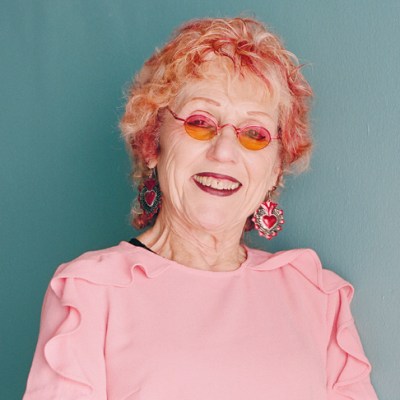Beatrice Gibson’s ‘Crone Music’, currently at the Camden Arts Centre, takes its title from avant-garde composer Pauline Oliveros’s 1990 album of the same name, and draws on many musical, visual and textual sources. The show comprises a gallery with screenings of films curated by Gibson, another with monitors showing Gibson’s recordings of poets Eileen Myles and CAConrad reading to camera, and two films in the main galleries: I Hope I’m Loud When I’m Dead (2018) and Deux Soeurs Qui Ne Sont Pas Soeurs (Two Sisters who Are Not Sisters) (2019). There is also an events programme of readings, talks and workshops scheduled to take place throughout the exhibition run.
Installation view of Deux Soeurs Qui Ne Sont Pas Soeurs (Two Sisters who Are Not Sisters) in ‘Beatrice Gibson: Crone Music’ at Camden Arts Centre, 2019. Photo: Luke Walker. Courtesy the artist; © Beatrice Gibson

Based on an unrealised script by Gertrude Stein, Deux Soeurs Qui Ne Sont Pas Soeurs is set in contemporary Paris, reconfiguring Stein’s 20th-century sensibility in the 21st: in a launderette, on the streets. Her Parisian characters are African, Brazilian, Palestinian, and queer. Most are artists she knows and works with and one is a woman who was her son’s carer; pregnant film-maker Basma Alsharif addresses her unborn child, and Brazilian artist Ana Vaz contemplates life and politics. These collaborators ventriloquise Stein in a mash-up of texts and ideas that works as a sort of thriller – there’s a storyline featuring a lost dog, a reference to Stein and Alice B. Toklas’s poodle, Basket – as well as a homage to, a reincarnation of, the 20th-century avant-garde.
I Hope I’m Loud When I’m Dead (film still; 2018), Beatrice Gibson. Courtesy the artist; © Beatrice Gibson

Collaborations, and motherhood, are at the centre of both films. In I Hope I’m Loud When I’m Dead, named after a poem by Conrad, the aim seems to be to create a sort of time capsule to leave for Gibson’s children in a troubled and uncertain world. Flashing images of Donald Trump, Grenfell, Brazil, and Gaza offer a dystopian backdrop cut with joyful footage of Gibson’s children and partner, on beaches or at home, and of Myles’ New York apartment in which Conrad and Myles read poems, consult tarot cards and converse. The film concludes with a performance: on a mirrored dance floor, Gibson and her son Obie re-enact Denis Lavant’s dance at the end of Claire Denis’ Beau Travail ≠(1999). It’s a celebration of motherhood and freedom, rock’n’roll and feminism, an affirmation of existing in the margins in a time of rising fascism – it’s a happy ending.
The strategy of collage reaches beyond the individual films, which though different are deeply interconnected – the poodle and the dance floor appear in both films. They’re ‘edgeless’, as Gibson says of herself in I Hope I’m Loud When I’m Dead. They are also both engaging and entertaining, combining personal narrative and other voices in a thrilling interpretation of what artists’ film can be.
I Hope I’m Loud When I’m Dead (film still; 2018), Beatrice Gibson. Courtesy the artist; © Beatrice Gibson

I was left wondering: who is Beatrice Gibson, where is she coming from, why does she ventriloquise and collaborate across class, gender, culture, time? She is a Goldsmiths graduate, based in London and half French (her mother lives in Paris). Aware that she’s white and privileged, Gibson acknowledges her access to the networks and contacts that secured her funding and support from a range of sources. In her quest to collaborate and embrace diversity, she claims a vast range of allies, whether through citation or direct participation. Yet she’s there, at the centre: she’s the mother of the children under the camera’s gaze, she dances, she crash-edits the texts of others, surfing across genre and time.
‘Beatrice Gibson: Crone Music’ is at Camden Arts Centre, London, until 31 March.



